Question 1
A student wants to make a heating coil that will have a power output of 48 W when there is a potential difference of 12 V across it. The student has a reel of nichrome wire of diameter 0.24 mm. The resistivity of nichrome is 1.3 × 10−6 Ω.m. Calculate the length of wire that the student requires.
Easy
Mark as Complete
Mark Scheme
Question 2
a. Calculate the potential difference across a motor carrying a current of 1.0 A and having a resistance of 50 Ω.
b. Calculate the potential difference across the same motor when the current is doubled. Assume its resistance remains constant.
Easy
Mark as Complete
Mark Scheme
Question 3
Sketch the I–V characteristic of:
a. A filament lamp.
b. A metallic conductor at constant temperature.
c. A semiconductor diode.
Easy
Mark as Complete
Mark Scheme
Question 4
a. The output of a heater is 2.5 kW when connected to a 220 V supply.
i. Calculate the resistance of the heater.
"ii. The heater is made from a wire of cross-sectional area 2 × 10-7 m2 and resistivity 1.1 × 10-6 Ω.m.
Use your answer in i to calculate the length of the wire.
b. The supply voltage is changed to 110 V.
i. Calculate the power output of the heater at this voltage, assuming there is no change in the resistance of the wire.
ii. State and explain quantitatively one way that the wire of the heater could be changed to give the same power as in a.
Medium
Mark as Complete
Mark Scheme
Question 5
Which graph could show how the resistance R of a filament lamp varies with the applied potential difference (p.d.) V, as V is increased to the normal operating p.d.?
Medium
Mark as Complete
Mark Scheme
Question 6
A circuit is set up with an LDR and a fixed resistor as shown.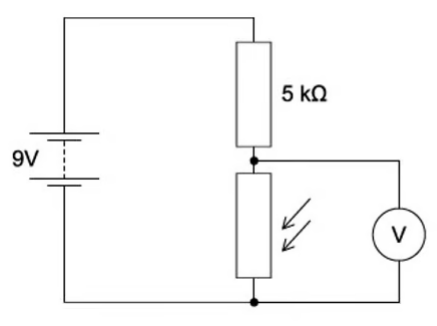 The voltmeter reads 4 V. The light intensity is increased. What is a possible voltmeter reading?
The voltmeter reads 4 V. The light intensity is increased. What is a possible voltmeter reading?
A. 3 V.
B. 4 V.
C. 6 V.
D. 8 V.
Medium
Mark as Complete
Mark Scheme
Question 7
The potential difference (p.d.) across a filament lamp is increased.
Which statement is correct?
A. The resistance of the lamp decreases because the temperature decreases.
B. The resistance of the lamp decreases because the temperature increases.
C. The resistance of the lamp increases because the temperature decreases.
D. The resistance of the lamp increases because the temperature increases.
Easy
Mark as Complete
Mark Scheme
Question 8
Which graph best represents the way in which the current I through a thermistor depends upon the potential difference V across it?
Medium
Mark as Complete
Mark Scheme
Question 9
A 2 Ω resistor and a 4 Ω resistor are connected to a cell. 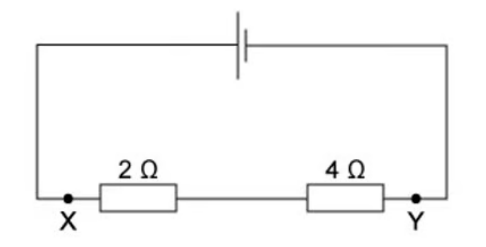 Which graph shows how the potential V varies with distance between X and Y?
Which graph shows how the potential V varies with distance between X and Y?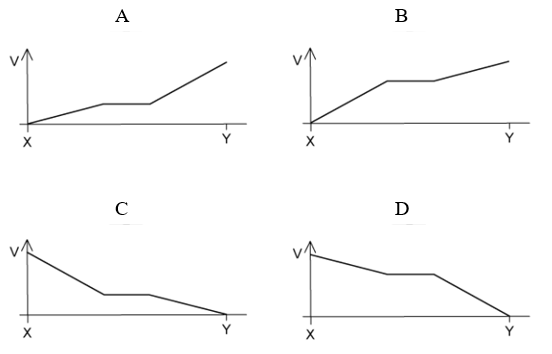
Hard
Mark as Complete
Mark Scheme
Question 10
Two wires P and Q made of the same material are connected to the same electrical supply. P has twice the length of Q and one-third of the diameter of Q, as shown in the diagram.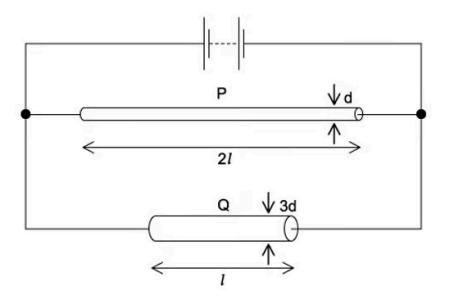 What is the ratio `"current in P"/"current in Q"`?
What is the ratio `"current in P"/"current in Q"`?
A. `2/3`.
B. `2/9`.
C. `1/6`.
D. `1/18`.
Hard
Mark as Complete
Mark Scheme
Question 1
A student wants to make a heating coil that will have a power output of 48 W when there is a potential difference of 12 V across it. The student has a reel of nichrome wire of diameter 0.24 mm. The resistivity of nichrome is 1.3 × 10−6 Ω.m. Calculate the length of wire that the student requires.
The resistance of the coil: `P = V^2 / R => R = V^2 / P = 12^2 / 48 = 144 / 48 = 3" "Omega`
Now, `R = ρxxL / A => L = RxxA / ρ` and `A = πxx(d/2)^2`
`A = πxx(0.24 × 10^-3 / 2)^2 = πxx(0.12 × 10^-3)^2 ≈ πxx(1.44 × 10^-8) ≈ 4.52 × 10^-8 " m"^2`
`L = (3 xx 4.52 × 10^-8) / (1.3 × 10^-6) ≈ (1.356 × 10^-7) / (1.3 × 10^-6) = "10.4 m"`
Question 2
a. Calculate the potential difference across a motor carrying a current of 1.0 A and having a resistance of 50 Ω.
b. Calculate the potential difference across the same motor when the current is doubled. Assume its resistance remains constant.
a. `V = Ixx R = 1.0 xx 50 = "50 V"`
b. Potential difference ∝ current, therefore double the current, the p.d. must have been doubled.
So, `50 xx 2 = "100 V"`
Question 3
Sketch the I–V characteristic of:
a. A filament lamp.
b. A metallic conductor at constant temperature.
c. A semiconductor diode.
a. 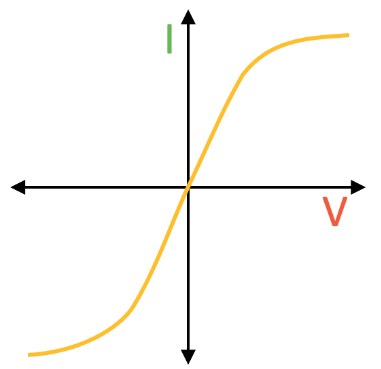 As the current increases, the temperature of the filament in the lamp increases.
As the current increases, the temperature of the filament in the lamp increases.
The higher temperature causes an increase in resistance.
Resistance opposes current, causing the current to increase at an increasingly slower rate.
b. 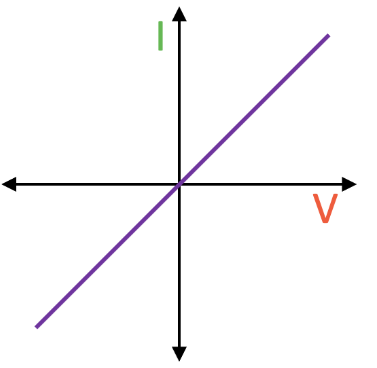
The current is directly proportional to the potential difference.
This is demonstrated by the straight line graph through the origin.
c. 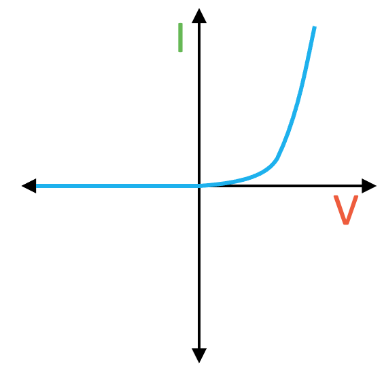 A diode is used in a circuit to allow current to flow only in a specific direction:
A diode is used in a circuit to allow current to flow only in a specific direction:
When the current is in the direction of the arrowhead symbol, this is forward bias. This is shown by the sharp increase in potential difference and current on the right side of the graph.
When the diode is switched around, it does not conduct and is called reverse bias. This is shown by a zero reading of current or potential difference on the left side of the graph.
Question 4
a. The output of a heater is 2.5 kW when connected to a 220 V supply.
i. Calculate the resistance of the heater.
"ii. The heater is made from a wire of cross-sectional area 2 × 10-7 m2 and resistivity 1.1 × 10-6 Ω.m.
Use your answer in i to calculate the length of the wire.
b. The supply voltage is changed to 110 V.
i. Calculate the power output of the heater at this voltage, assuming there is no change in the resistance of the wire.
ii. State and explain quantitatively one way that the wire of the heater could be changed to give the same power as in a.
a.
i. `R = V^2 / P = 220^2 / 2500 = 19.36 " "Omega`
ii. `L = Rxx A / rho = (19.36 xx 2.0 xx 10^-7) / (1.1 xx 10^-6) = "3.52 m"`
b.
i. `P = V^2 / R = 110^2 / 19.36 = "625 W"`
ii. To maintain the same power (2500 W) at `V`
Question 5
Which graph could show how the resistance R of a filament lamp varies with the applied potential difference (p.d.) V, as V is increased to the normal operating p.d.?
Answer: A
A. Correct:
Resistance increases with voltage in a nonlinear but overall increasing way.
In a filament lamp, as voltage increases, the current heats the filament.
Higher temperature → higher resistance.
B. Incorrect:
Looks like current–voltage (I–V) curve, not R–V.
It's a confused plot — resistance isn’t initially steep then flattening like that.
Remember: `R=V/I`, and I grows more slowly at high V → so R increases.
C. Incorrect:
Flat line means resistance stays constant.
That’s only true for ohmic resistors.
A filament lamp is non-ohmic → resistance changes with temperature.
D. Incorret:
This shows resistance decreasing with voltage.
That’s what you’d expect for a negative temperature coefficient (NTC) thermistor.
Not for a filament lamp.
Question 6
A circuit is set up with an LDR and a fixed resistor as shown. The voltmeter reads 4 V. The light intensity is increased. What is a possible voltmeter reading?
The voltmeter reads 4 V. The light intensity is increased. What is a possible voltmeter reading?
A. 3 V.
B. 4 V.
C. 6 V.
D. 8 V.
Answer: A
The resistance of an LDR decreases as the light intensity incident on it increases.
Ohm's law states `R=V/I`
The p. d. across a component is dependent on its resistance.
Since the resistance of the LDR decreases, the p. d. across it will also decrease.
Therefore, if the original p. d. is 4 V, the only possible reading it can be when the light intensity is increased is 3 V.
Question 7
The potential difference (p.d.) across a filament lamp is increased.
Which statement is correct?
A. The resistance of the lamp decreases because the temperature decreases.
B. The resistance of the lamp decreases because the temperature increases.
C. The resistance of the lamp increases because the temperature decreases.
D. The resistance of the lamp increases because the temperature increases.
A. Incorrect:
Voltage increases → temperature increases, not decreases.
And resistance doesn't decrease in a filament lamp.
B. Incorrect:
Temperature does increase, but that causes resistance to increase, not decrease.
Opposite behavior of a filament lamp.
C. Incorrect:
Resistance and temperature both increase together in a filament lamp.
This is physically incorrect.
D. Correct:
When voltage increases → current increases → the filament gets hotter.
As the temperature rises, the metal atoms in the filament vibrate more, making it harder for electrons to flow.
This causes the resistance to increase.
Question 8
Which graph best represents the way in which the current I through a thermistor depends upon the potential difference V across it?
Answer: A
A. Correct:
As the potential difference V across the thermistor increases, the temperature of the thermistor also increases, causing its resistance R to decrease.
Ohm's law states `V=IxxR`
As the p.d. increases, the current increases - this is represented by a positive gradient in the graph.
Resistance is equal to `V/I`.
As the resistance R decreases, the value of `1/R` increases, so, the ratio `V/I` increases.
So, current I increases with the p .d., with an increasing gradient since the resistance `R` is also decreasing as the p. d. increases.
B. Incorrect: The resistance of the thermistor decreases as p .d. increases, so it does not obey Ohm's Law.
C. Incorrect: The resistance of the thermistor decreases as p. d. increases, whereas this graph shows the resistance decreasing.
D. Incorrect: when the p. d. increases, the current increases so the graph should have a positive gradient.
Question 9
A 2 Ω resistor and a 4 Ω resistor are connected to a cell.  Which graph shows how the potential V varies with distance between X and Y?
Which graph shows how the potential V varies with distance between X and Y?
Answer: D
A. Incorrect: The potential at point X is E and point Y is zero so the gradient should decrease.
B. Incorrect: The potential at point X is E and point Y is zero so the gradient should decrease.
C. Incorrect: Ohm's Law tells us that `VpropR`, so the gradient is steeper across the 4 Ω resistor and shallower across the 2 Ω resistor.
D. Correct:
The cell has E. The negative terminal of the cell is usually taken to be at a potential of 0 V while the positive terminal is taken to be at a potential of E.
So, the positive terminal is at a higher potential than the negative terminal.
No component is connected between the positive terminal and point X, so they are at the same potential.
Therefore, point X is at potential E, while, point Y is at the same potential as the negative terminal of the cell, so, the potential at Y is zero.
Ohm's Law states `V=IxxR`
Therefore, the p. d. across the 2 Ω resistor must be less than the p .d. across the 4 Ω resistor. That is, the change in potential across the 4 Ω resistor is more significant than that across the 2 Ω resistor.
In the graph, this is represented by the gradient. The gradient across the 4 Ω resistor, which is just before point Y, is steeper than that across the 2 Ω resistor which is just after point X.
Question 10
Two wires P and Q made of the same material are connected to the same electrical supply. P has twice the length of Q and one-third of the diameter of Q, as shown in the diagram. What is the ratio `"current in P"/"current in Q"`?
What is the ratio `"current in P"/"current in Q"`?
A. `2/3`.
B. `2/9`.
C. `1/6`.
D. `1/18`.
Answer: D
Explanation:
Ohm's law states `V = IR`
From Kirchhoff’s Second Law the p.d. is the same across P and Q.
So, ratio `I_P / I_Q = R_Q / R_P`
The resistance of a wire is given by `R = (rho xx L) / A`
Cross-sectional area is equal to `pi xx r^2 = pi xx (d / 2)^2 = (pi xx d^2) / 4`
So, `R = (rho xx L) / A = rho xx L xx (4 / (pi xxd^2))`
For wire Q, the length is `L`, and the diameter is `3d`.
So, the resistance of wire Q:
`R_Q = rho xx L xx (4 / (pi xx (3d)^2)) = (4 / 9) xx (rho xx L / (pi xx d^2))`
For wire P, the length is `2L`, and the diameter is `d`.
So, the resistance of wire P:
`R_P = rho xx (2L) xx (4 / (pi xx d^2)) = 8 xx (rho xxL / (pi xx d^2))`
`I_P / I_Q = R_Q / R_P = (4 / 9) xx (rho xx L / (pi xx d^2)) / (8 xx (rho xx L / (pi xx d^2)))`
`= (4 / 9) xx (1 / 8) = 1 / 18`
Question 1
A student wants to make a heating coil that will have a power output of 48 W when there is a potential difference of 12 V across it. The student has a reel of nichrome wire of diameter 0.24 mm. The resistivity of nichrome is 1.3 × 10−6 Ω.m. Calculate the length of wire that the student requires.
Question 2
a. Calculate the potential difference across a motor carrying a current of 1.0 A and having a resistance of 50 Ω.
b. Calculate the potential difference across the same motor when the current is doubled. Assume its resistance remains constant.
Question 3
Sketch the I–V characteristic of:
a. A filament lamp.
b. A metallic conductor at constant temperature.
c. A semiconductor diode.
Question 4
a. The output of a heater is 2.5 kW when connected to a 220 V supply.
i. Calculate the resistance of the heater.
"ii. The heater is made from a wire of cross-sectional area 2 × 10-7 m2 and resistivity 1.1 × 10-6 Ω.m.
Use your answer in i to calculate the length of the wire.
b. The supply voltage is changed to 110 V.
i. Calculate the power output of the heater at this voltage, assuming there is no change in the resistance of the wire.
ii. State and explain quantitatively one way that the wire of the heater could be changed to give the same power as in a.
Question 5
Which graph could show how the resistance R of a filament lamp varies with the applied potential difference (p.d.) V, as V is increased to the normal operating p.d.?
Question 6
A circuit is set up with an LDR and a fixed resistor as shown. The voltmeter reads 4 V. The light intensity is increased. What is a possible voltmeter reading?
The voltmeter reads 4 V. The light intensity is increased. What is a possible voltmeter reading?
A. 3 V.
B. 4 V.
C. 6 V.
D. 8 V.
Question 7
The potential difference (p.d.) across a filament lamp is increased.
Which statement is correct?
A. The resistance of the lamp decreases because the temperature decreases.
B. The resistance of the lamp decreases because the temperature increases.
C. The resistance of the lamp increases because the temperature decreases.
D. The resistance of the lamp increases because the temperature increases.
Question 8
Which graph best represents the way in which the current I through a thermistor depends upon the potential difference V across it?
Question 9
A 2 Ω resistor and a 4 Ω resistor are connected to a cell.  Which graph shows how the potential V varies with distance between X and Y?
Which graph shows how the potential V varies with distance between X and Y?
Question 10
Two wires P and Q made of the same material are connected to the same electrical supply. P has twice the length of Q and one-third of the diameter of Q, as shown in the diagram. What is the ratio `"current in P"/"current in Q"`?
What is the ratio `"current in P"/"current in Q"`?
A. `2/3`.
B. `2/9`.
C. `1/6`.
D. `1/18`.